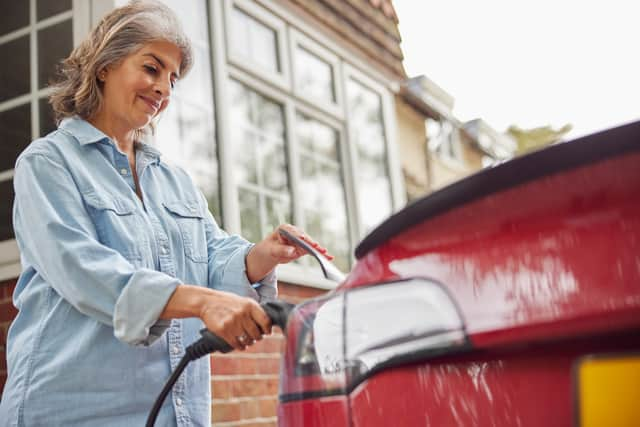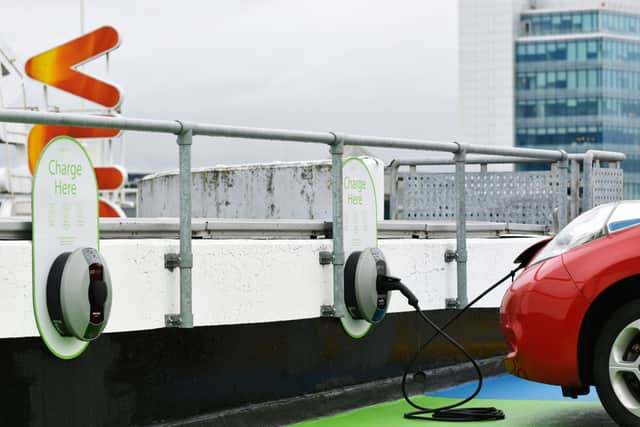How to save on EV charging: tips on keeping down electric car running costs as energy prices rise
and live on Freeview channel 276
New figures have suggested that charging an electric car can be up to 28% more expensive than topping up an equivalent petrol model.
A study by What Car? Found that charging at a motorway service station was more expensive than even the sky-high petrol prices. At the same time, EV owners who charge at home are facing the prospect of a spike in energy costs from October.
Advertisement
Hide AdAdvertisement
Hide AdNonetheless, in many cases it’s still cheaper to run an EV than a petrol or diesel model and there are steps EV drivers new and old can take to keep their charging costs down.
Steps like:
Charge at home and choose the right tariff
Even at current energy prices, charging your EV at home is generally cheaper than using a public charger. Prices at public sites can exceed 70p per kWh and there are fears that providers could put costs up further in response to rising energy prices.
If you regularly charge your EV at home it pays to ensure you are on a favourable electricity tariff. Some energy companies, such as Octopus and Bulb, offer specific EV rates for drivers with costs as low as 6.7p per kWh.
Some energy companies also offer off-peak or time of use tariffs where you’ll pay less for electricity used at times of low demand - typically overnight. Sadly, with prices soaring these aren’t as easy to find these days but if you’re already on one make sure you time your charges to match the best rates.
Advertisement
Hide AdAdvertisement
Hide Ad

Choose your public charger carefully
If you do have to charge in public it pays to be smart about which chargers you use. Different networks have different standard rates and some offer discounts to members. These can cut prices by up to 12p per kWh but be aware of any subscription fees.
Different speeds of charger also attract different prices, so think about how fast you need to fill up and what your car is capable of. There’s no point in paying 69p/kWh for a 350kW charger if your car maxes out at 100kW or using an expensive rapid charger if you’re planning a longer stop where a slower speed would suffice.
Apps like Zap-Map and WattsUp will show you the speeds and prices of individual chargers, so you can find the most cost effective option near you.
Watch out for parking charges and overstay fees that can quickly push up the cost of a cheap charge.
Advertisement
Hide AdAdvertisement
Hide AdUse free chargers
Although they are getting harder to find, there are still some free-to-use public chargers that can provide a little extra charge while you are on the road.
Melanie Shufflebotham, COO of Zap-Map told National World: “There are around 4,000 charge points which are free to use around the country. Most of these are low powered ‘destination’ chargers - typically supermarkets or attractions - which will give you a top-up charge while you are out and about.”


Keep your charge between 20% and 80%
EV drivers are generally encouraged to keep their cars at between 20% and 80% charge. Not only do the first and last 20% of a full charge take longer but regularly letting your car run to empty then fully recharging it can degrade the battery. A degraded battery will provide less range and require more frequent charging, costing owners more in the long run.
Don’t always rapid charge
Constantly rapid charging your EV’s battery can also degrade it and isn’t advisable. According to car maker DS: “Rapid charging sends a huge current to the batteries in a short timeframe, straining the battery. If you can, try and rely on slower charges, such as overnight. That’s not to say you can’t use rapid charging, just use this only when necessary.”
Advertisement
Hide AdAdvertisement
Hide AdKeep it cool
EV batteries are pretty robust things but are still affected by extremes in temperature. Cold weather will cut a car’s range while high temperatures are also bad news and can affect a battery’s charging performance, which can end up costing you more.
If you’re charging in hot weather try and park your car in the shade to keep the battery as cool as possible.
Keep your car maintained
EVs in general require less maintenance than a combustion engine car but tyres are one area that still need attention for safety and economic reasons. Just like a petrol car, an EV running on under or over-inflated tyres won’t be at its most efficient, wasting battery power and money, so check your tyre pressures regularly.
Carrying excess weight or unnecessary drag is also just as bad for an EV as a ICE vehicle, so keep your car free of clutter and remove roof bars, boxes and bike racks when you’re not using them.
Advertisement
Hide AdAdvertisement
Hide AdUse pre-conditioning
Virtually all EVs feature a pre-conditioning function that lets you pre-warm or cool your car before starting a journey. Doing this while the car is plugged in and charging means you won’t waste energy once you’re on the road, meaning more miles between charges.
Drive smarter
EVs all feature eco modes and regenerative braking, both of which can help maximise efficiency and save on charging costs.
Eco mode alters everything from the throttle response to the air conditioning power and can help eke out several extra miles from your battery. Although it might slow the car’s responses slightly, many EVs are remarkably powerful compared with an equivalent petrol car, so you’ll still have plenty of get up and go when you need it.
While eco mode uses less power, regenerative braking actually helps generate more by turning the motor into a generator when slowing down. Many EVs have variable levels of recuperation that are suited to different driving conditions, so it’s worth exploring your options.
Finally, keep your speed down. Just like a petrol car, speeding in an EV uses more energy than sticking around the limit, so easing off the throttle will also be easier on your wallet.
Comment Guidelines
National World encourages reader discussion on our stories. User feedback, insights and back-and-forth exchanges add a rich layer of context to reporting. Please review our Community Guidelines before commenting.
